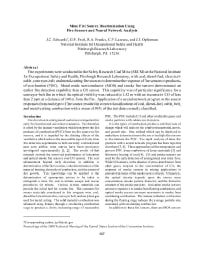Mining Publication: Mine Fire Source Discrimination Using Fire Sensors and Neural Network Analysis
Original creation date: April 2000
Authors: JC Edwards, GF Friel, RA Franks, CP Lazzara, JJ Opferman
NIOSHTIC2 Number: 20020920
Combustion Fundamentals and Applications - Proceedings of the 2000 Technical Meeting of the Central States Section of the Combustion Institute (April 17-18, 2000, Indianapolis, IN); :207-211
Fire experiments were conducted in the Safety Research Coal Mine (SRCM) at the National Institute for Occupational Safety and Health, Pittsburgh Research Laboratory, with coal, diesel-fuel, electrical cable, conveyor-belt, and metal-cutting fire sources to determine the response of fire sensors to products-of- combustion (POC). Metal oxide semiconductor (MOS) and smoke fire sensors demonstrated an earlier fire detection capability than a carbon monoxide sensor. This capability was of particular significance for a conveyor-belt fire in which the optical visibility was reduced to 1.52 m with an increase in carbon monoxide of less than 2 ppm at a distance of 148 m from the fire. Application of a neural-network program to the sensor responses from each type of fire source resulted in correct classifications of coal, diesel-fuel, cable, belt, and metal-cutting combustion with a mean of 96% of the test data correctly classified.

NIOSHTIC2 Number: 20020920
Combustion Fundamentals and Applications - Proceedings of the 2000 Technical Meeting of the Central States Section of the Combustion Institute (April 17-18, 2000, Indianapolis, IN); :207-211
- A Comparison of Mine Fire Sensors
- Impact of Air Velocity on the Detection of Fires in Conveyor Belt Haulageways
- In-Mine Evaluation of Smart Mine Fire Sensor
- In-Mine Evaluation of Smoke Detectors
- In-Mine Evaluation of Underground Fire and Smoke Detectors
- Multiple Type Discriminating Mine Fire Sensors
- Overview of Mine Fire Detection
- Rapid Detection and Suppression of Mining Equipment Cab Fires
- Real-time Neural Network Application to Mine Fire - Nuisance Emissions Discrimination
- Technology News 498 - Multiple Fire Sensors for Mine Fire Detection and Nuisance Discrimination